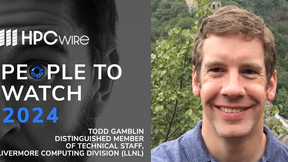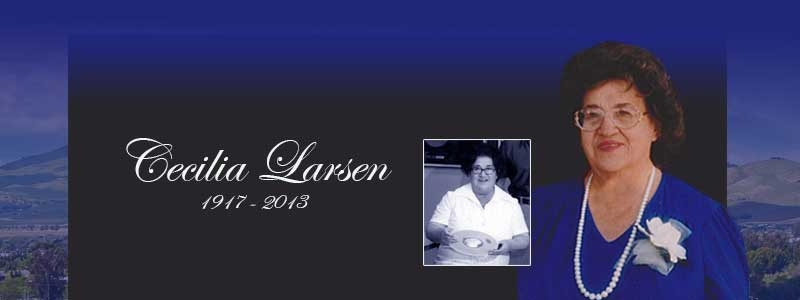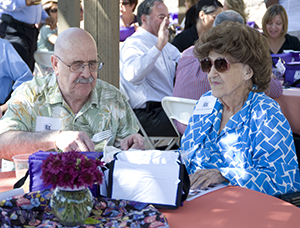LLNL woman pioneer Cecilia Larsen dies
Larsen was born on March 15, 1917, to John and Mary Azevedo. She was born and lived her entire life in Livermore. Her parents both emigrated from Portugal and owned a small general store for many years. She had two sisters, Mary and Margaret and a brother, Richard.
Larsen attended St. Michael's Grade School and Livermore High School. She went on to graduate with a bachelor's degree from Dominican College in San Rafael under a full scholarship.She attended the University of California, Berkeley receiving a master's degree in history, a general secondary teaching certificate and a technical writing certificate. Larsen also attended the University of San Francisco receiving a certificate in music.
Larsen was widowed in 1943 with two small children to care for. She held many jobs to support her children and widowed mother. They included a telephone switchboard operator, a baker, a cannery worker and high school teacher.
In 1951 she answered an ad and was hired as a "Girl Friday" for a small University of California branch office in Livermore. After an internship at the Radiation Laboratory in Berkeley, now known as Lawrence Berkeley National Laboratory, she went back to Livermore as one of the first 66 employees, one of the first women and the first Livermore resident to start up what would eventually become the Lawrence Livermore National Laboratory.
As a "Girl Friday," Larsen basically did everything that needed to be done in addition to her regular job as a secretary. She ordered the furniture and set up the office of Edward Teller, processed badge requests, badge checks and was a telephone operator. It is rumored that somewhere there is a copy of the first LLNL telephone directory in Larsen's handwriting -- with 30 names on it.
Larsen spent the first years working with Teller, Ernest Lawrence, Duane Sewell, Sid Fernbach and Herb York. She helped start up the Lab's first computer center and was sent to Philadelphia to learn to run the Univac, the Lab's first computer. In a 1983 interview with Patricia Haddad, Larsen said: "There was only one way to get information into that machine. You had to type on a machine that was about nine feet high, three feet wide and two feet deep that had magnetic tape on it. You had no way of seeing what you were putting on that tape, so you had to be extremely careful that you didn't make a mistake."
George Michael, a pioneering computational physicist at LLNL, worked with Larsen at the Lab beginning in 1953. In 1996, he interviewed Larsen on her experience and memories of the early days. Michael remembers coming to the Lab as a young person in 1953. "One of the great stabilities of the place and the era and so forth was Cecilia Larsen. She always remembered everything and she knew where everything was. She never flapped; she never lost her temper. That was very important to all of us young guys who didn't know what the heck we were doing," he said.
Larsen remained in Computation for the remainder of her 40-year career at the Lab and retired in 1991. While working in Computation, Larsen became friends with Jeff Painter who then introduced her to his wife Corry Painter. Jeff Painter remembers riding the bus with her to work in the 1980s. "She was an excellent conversationalist, one of the few people who can keep a conversation going with someone who talks as little as me," he said. Corry Painter also became good friends with Larsen. "She was one of the smartest people I knew. Her mind stayed sharp. Even last year when I talked to her, she could remember what graduate schools my children were attending. She remembered all of her colleagues, where they went for their retirement and what their children were doing. I think if she were to have been born in 2017 instead of 1917, she would have been another Marissa Meyer or Sheryl Sandberg, a trailblazer for her generation."
Larsen was one of the founders of the LLL Women's Association and served as president for two consecutive terms from 1975 to 1977. Larsen was named the Lab's Woman of the Year in 1982, and also received the first LLLWA Special Award in 1987. She continued her support after retirement and would attend the annual LLLWA luncheons. She was recognized as a past LLLWA president at last year's event, which she attended at the age of 95.
Through the years, Larsen also participated in panel discussions on the early days of the Lab offering her many insights and anecdotes.
Larsen was a founding member of the Stanford Computer Museum History Center and was a lifetime member of St. Michael Catholic church. She was a longtime member of the church choir and served as their publicity person sending information to the Catholic Voice , the weekly newspaper of the Diocese of Oakland.
Larsen is survived by two children, Kirsten Alderson and Stephen Larsen; her sister, Margaret Roemer, six grandchildren, six great grandchildren and one great-great grandchild.
A vigil will be held on Monday, Oct. 28, at Saint Michael Church, 458 Maple St. in Livermore from 5 to 7 p.m. Mass will be celebrated at Saint Michael Church at 11 a.m. Oct. 29, followed by interment at Saint Michael Cemetery in Livermore.
In lieu of flowers or gifts, consider a donation in Larsen's name to: Dominican University of California, 50 Acacia Ave., San Rafael, Calif. 94901.
Contact
Carenda L Martin[email protected]
925-424-4175
Related Files
DownloadTags
HPC, Simulation, and Data ScienceComputing
Featured Articles









